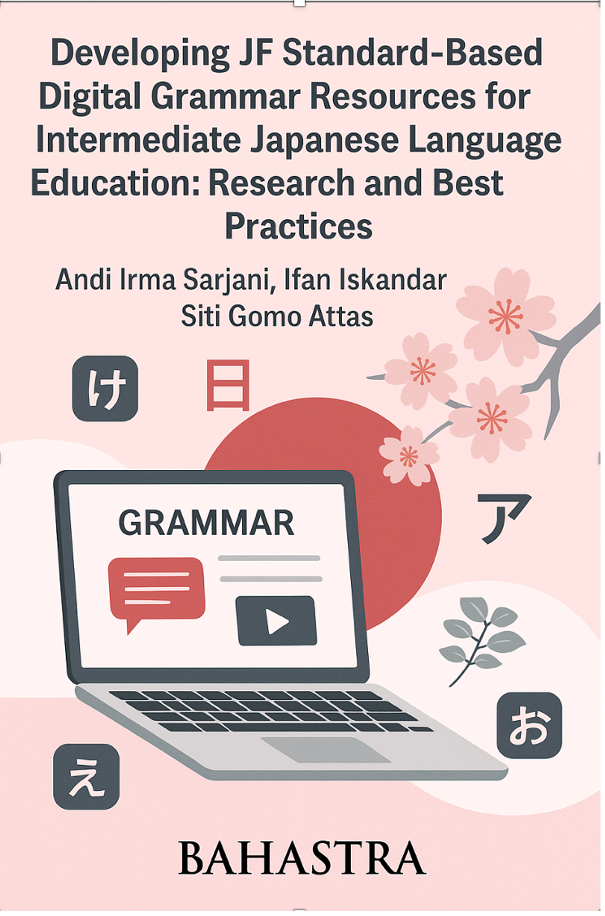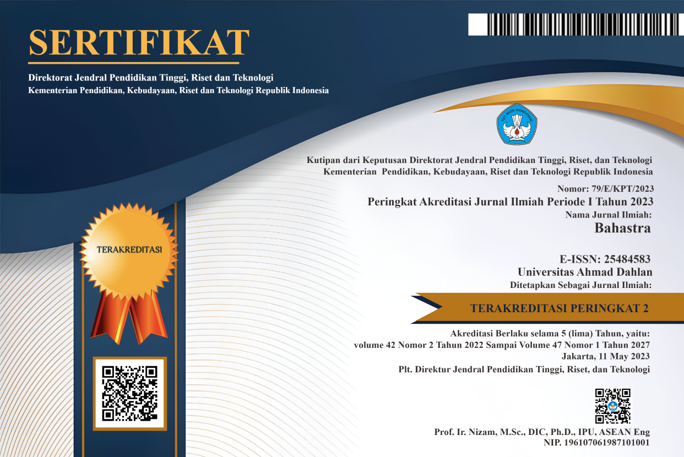Developing JF standard-based digital grammar resources for intermediate Japanese language education: Research and best practices
DOI:
https://doi.org/10.26555/bs.v45i2.1652Keywords:
digital learning resources, intermediate proficiency, Japanese grammar instruction, JF StandardAbstract
Japanese language education in Indonesia faces critical challenges in intermediate grammar instruction regarding alignment with international standards, active learning integration, and digital resource availability. This study evaluates existing intermediate Japanese grammar materials against JF Standard requirements and develops a practical framework for creating digital resources. Employing design-based research methodology, this study analyzed materials from 10 Indonesian universities, conducted needs analysis surveys with 105 intermediate learners, developed the "Nihongo with Irma Sensei" prototype, and validated materials through expert evaluation and field testing. Findings reveal substantial gaps: 0% inclusion of JF Standard components (Can-do statements, communicative competence frameworks, learner portfolios), 15% active learning integration, and 8% digital availability. Field testing showed 96% participant interest in digital materials and 96.1% acknowledged enhanced comprehension. The study identifies five best practices: contextualized presentation through multimedia, interactive exercises with immediate feedback, multimodal approaches, strict JF Standard alignment, and user-centered design. This research demonstrates the feasibility and effectiveness of JF Standard-aligned digital materials leveraging multimedia technologies to facilitate contextualized and communicative language learning.
References
Alkhawaldeh, A. (2020). A research investigation of contextualized grammar instruction from the perspective of English language lecturers and students at Al-Imam Mohammad Ibn Saud Islamic University. International Journal of English Linguistics, 10(5), 162-175. https://doi.org/10.5539/IJEL.V10N5P162
Alla, F., Paladieva, V. O., Pavlyuk, G. O., Bondar, & Honcharuk, V. (2023). Implementation of interactive methods learning in theoretical English grammar classes. Pedagogy and Education Management Review, 1, 58-65. https://doi.org/10.36690/2733-2039-2023-1-58
Archer, A. H. (2022). A multimodal approach to English for academic purposes in contexts of diversity. World Englishes, 41(4), 567-580. https://doi.org/10.1111/weng.12600
Ayaka, N. (2023). Exploring the possibilities and challenges in developing the Japanese Qualifications Framework. Higher Education Evaluation and Development, 17(1), 39-54. https://doi.org/10.1108/HEED-05-2022-0019
Bondarenko, A., & Gudkova, N. (2023). Enhancing foreign language teaching through digital tools and resources. Logos: Art of Scientific Thought, 6, 35-42. https://doi.org/10.36074/logos-23.06.2023.35
Cambridge Assessment International Education. (2008). Active learning. Cambridge Assessment International Education.
Council of Europe. (2001). Common European framework of reference for languages: Learning, teaching, assessment. Cambridge University Press.
Cyfeku, J. (2022). Technology integration and SkELL: A novelty in English Foreign Language teaching and learning. The Eurasia Proceedings of Science Technology Engineering and Mathematics, 19, 184-192. https://doi.org/10.55549/epstem.1219184
Djafri, F. (2018). Analisis naratif pada proses pembelajaran bahasa Jepang di perguruan tinggi dan pengaruhnya terhadap pilihan masa depan pembelajar setelah lulus. Jurnal Lingua Aplicata, 1(2), 78-95. https://doi.org/10.22146/jla.34516
Duran, E. E., & Weichselbaumer, C. (2020). Developing digital literacy in online grammar teaching and learning. The EuroCALL Review, 28(1), 66-73. https://doi.org/10.26352/DY14_2384-9509
Eddeen, Z. B. (2022). Effectiveness of explicit communicative instruction on improving Palestinian English majors' grammaring of conditionals. International Journal of Linguistics, Literature, and Translation, 5(11), 162-175. https://doi.org/10.32996/ijllt.2022.5.11.16
Fandi, S. (2022). Integrating digital technologies in teaching and learning through participation: Case studies from the Xlab—Design, Learning, Innovation Laboratory. Springer Proceedings in Education. Springer. https://doi.org/10.1007/978-3-031-14583-4_7
Ghinea, G., & Chen, S. Y. (2006). Digital multimedia perception and design. Digital Multimedia Perception and Design, 1-15. https://doi.org/10.4018/978-1-59140-860-4
Huang, J., & Cao, H. (2023). Effects of bilingual videos in national innovation project in college English listening teaching under the influences of multi-modal theory. International Journal of Education and Humanities, 8(3), 113-117. https://doi.org/10.54097/ijeh.v8i3.8703
Isaiah, T., Awidi, & Paynter, M. (2022). An evaluation of the impact of digital technology innovations on students' learning: Participatory research using a student-centred approach. Technology, Knowledge, and Learning, 27(4), 1157-1180. https://doi.org/10.1007/s10758-022-09619-5
Japan Foundation. (2010). JF Standard for Japanese-Language Education 2010. https://jfstandard.jp/pdf/jfs2010_all_en.pdf
Karpenko, Y., & Golovko, I. S. (2023). Intersubject integration of chemical disciplines with the help of digital technologies. Revista Tempos e Espaços em Educação, 16(35), 1-14. https://doi.org/10.31909/26168812.2023-(62)-11
Komarudin, R., & Noor, R. R. (2017). Analisis perancangan media pembelajaran animasi interaktif mengenal bahasa Jepang. Jurnal Pilar Nusa Mandiri, 13(1), 12-20.
Librenjak, S., Kocijan, K., & Janjić, M. (2016). Improving students' language performance through consistent use of e-learning: An empirical study in Japanese, Korean, Hindi and Sanskrit. Acta Linguistica Asiatica, 6(2), 79-94. https://doi.org/10.4312/ala.6.2.79-94
Lorena, M. P., Carmen, L. C., & Julio, B. O. (2023). Self-perception of digital competence in university lecturers: A comparative study between universities in Spain and Peru according to the DigCompEdu model. Societies, 13(6), 142. https://doi.org/10.3390/soc13060142
Mahdi, K. S., & Ismail, N. (2022). Investigating the effect of grammatical competence strategies in teaching writing skills. Horizon Journal of Humanities & Social Sciences Research, 1(1), 11-20. https://doi.org/10.33687/jhssr.001.01.00011
Marasigan, M. J. (2023). Digital game-based second language learning of JLPT N5 & N4 grammatical concepts for Japanese. Lecture Notes in Computer Science, 13891, 81-94. https://doi.org/10.1007/978-3-031-28993-4_7
Mardieva, G. (2022). Methodological recommendations for teaching grammar and improving grammar skills. Zamonaviy Lingvistik Tadqiqotlar, 1(1), 292-294. https://doi.org/10.47689/linguistic-research-vol-iss1-pp292-294
Masaki, Ô. (2023). Contextualisation of CEFR and its application to the study of Japanese language and Japanese language teaching. Impact, 2023(1), 38-40. https://doi.org/10.21820/23987073.2023.1.38
Masterson, M. (2020). An exploration of the potential role of digital technologies for promoting learning in foreign language classrooms: Lessons for a pandemic. International Journal of Emerging Technologies in Learning, 15(14), 83-96. https://doi.org/10.3991/ijet.v15i14.13297
McKenney, S., & Reeves, T. C. (2019). Conducting educational design research (2nd ed.). Routledge. https://doi.org/10.4324/9781315105642
Mulyadi, M. (2013). Riset desain dalam metodologi penelitian. Jurnal Studi Komunikasi dan Media, 16(1), 71-85. https://doi.org/10.31445/jskm.2012.160106
Nagai, N., & O'Dwyer, F. (2011). The actual and potential impacts of the CEFR on language provision in higher education in Japan. Synergies Europe, 6, 137-152.
Nathaniel, G., Gido, L. M., Rojoca, L. J., Cabañero, M., Cañedo, I. H., La Cruz, & Villaceran, S. (2022). Contextualized instruction for speech communication. International Journal of Multidisciplinary Research and Studies, 5(9), 1-12. https://doi.org/10.33826/ijmras/v05i09.3
Ngoc Vu, N., Hai, T. L., Ha, T. N., & Tien, B. D. (2023). Exploring the effect of LearnEnglish Grammar mobile app on English language learners' grammatical competence. Rupkatha Journal on Interdisciplinary Studies in Humanities, 15(1), 1-15. https://doi.org/10.21659/rupkatha.v15n1.04
Patrick, A., & Tina, S. (2023). The modality effect reverses in a virtual reality learning environment and influences cognitive load. Instructional Science, 51(2), 265-286. https://doi.org/10.1007/s11251-022-09611-7
Pichkova, L. S., Karavaeva, E. M., & Kulemekova, M. V. (2023). The role of digital technologies in foreign language learning in the context of life-long learning paradigm. Pravo i Upravlenie. XXI Vek, 19(1), 66-73. https://doi.org/10.24833/2073-8420-2023-1-66-66-73
Quines, Z. M. (2023). Grammatical competence and its impact to listening and speaking proficiency: An analysis. European Journal of English Language and Literature Studies, 11(2), 112-125. https://doi.org/10.37745/ejells.2013/vol11n2112
Rosi, R., Elensyah, A., & Machawan, R. (2019). Application of e-learning in Japanese learning at Japanese Language Education Program Universitas Muhammadiyah Yogyakarta. Advances in Social Science, Education and Humanities Research, 313, 156-160. https://doi.org/10.2991/ICOSIHESS-19.2019.31
Rusli, M., & Nurahman. (2012). Aplikasi belajar bahasa Jepang berbasis Android. Jurnal Teknologi Informasi, 8(2), 1-8.
Satrio, D., & Murtisari, E. T. (2023). Perceived effects of peer teaching: Does it enhance learner autonomy in grammar learning? LLT Journal: A Journal on Language and Language Teaching, 26(1), 262-279. https://doi.org/10.24071/llt.v26i1.5333
Sik, K., & Razi, S. (2023). Innovative instructional tools in vocabulary and grammar teaching. International Journal of Innovative Approaches in Education, 7(2), 140-156. https://doi.org/10.29329/ijiape.2023.540.2
Soo, J. Y. (2023). Grammar as validity evidence for assessing L2 interactional competence. Applied Pragmatics, 5(1), 86-112. https://doi.org/10.1075/ap.00012.you
Soukotta, R. O. C. (2023). Exploring challenges in learning grammar during Covid-19 era. Journal of English Language and Pedagogy, 1(1), 25-34. https://doi.org/10.51826/jelpa.v1i1.739
Sunarti, Rangga, R. Y., & Damhudi, D. (2016). Aplikasi pembelajaran huruf hiragana dan katakana dilengkapi dengan suara berbasis android. Jurnal Teknologi dan Sistem Informasi, 14(1), 9-16.
Suparmi, S., Yelliza, Y., & Yuneva, Y. (2022). Problems faced by the intermediate level students during English speech. Jurnal Maneksi, 11(1), 232-239. https://doi.org/10.31959/jm.v11i1.1071
Syafitri, Y., & Sari, U. A. (2015). Pemanfaatan animasi dua dimensi untuk pembelajaran bahasa Jepang tingkat dasar. EXPERT: Jurnal Manajemen Sistem Informasi dan Teknologi, 5(1), 1-12. https://doi.org/10.36448/jmsit.v5i1.714
Tadiosa, M. J. P., & Diva, C. B. (2023). Using video-based ebook in teaching writing for the enhancement of grammatical competence among ESL learners. Asia Pacific Journal of Academic Research in Business Administration, 9(1), 1-12. https://doi.org/10.54476/apjaet/99994
Tania, K. R. (2023). Learning strategy of successful students in an online intermediate grammar class. Indonesian Journal of English Language Teaching and Applied Linguistics, 3(2), 233-248. https://doi.org/10.21111/ijelal.v3i2.9740
Xiaoyu, F., Ketong, L., Xiangwen, W., & Jiawei, Y. (2023). Exploring mobile apps in English learning. Journal of Education, Humanities, and Social Sciences, 8, 799-806. https://doi.org/10.54097/ehss.v8i.4996
Yella, D. P. (2022). Enhancing the students' grammar comprehension by utilizing the video-based instruction. Proceedings of the 2022 5th International Conference on Computers in Management and Business. ACM. https://doi.org/10.1145/3572549.3572600
Zhang, Z. (2022). "Give me the rules, I'll understand grammar better": Exploring the effectiveness of usage-based grammar approach through explicit instruction of adverbials. ETD Collection for University of Nebraska - Lincoln, AAI29257823. https://doi.org/10.30707/ETD2022.20221020070315049859.999962

Downloads
Published
Issue
Section
License
Copyright (c) 2025 Andi Irma Sarjani, Ifan Iskandar, Siti Gomo Attas

This work is licensed under a Creative Commons Attribution-ShareAlike 4.0 International License.

1.jpg)






